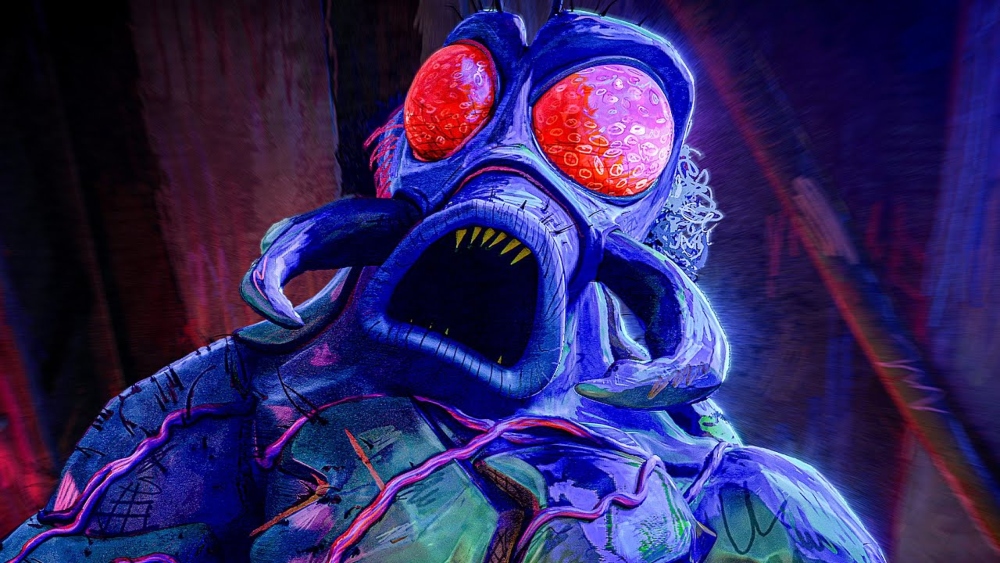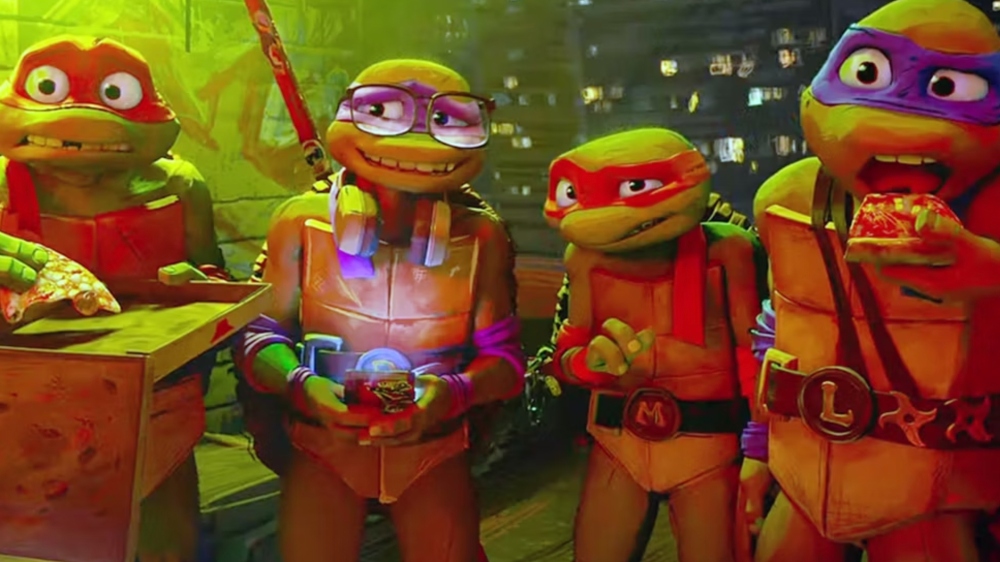After six previous feature films set in three separate timelines and released across as many decades — not to mention an array of comics, animated TV series, and video games, all similarly eager to put their own spin on the property first created by Kevin Eastman and Peter Laird in 1984 — Paramount’s new, computer-animated Teenage Mutant Ninja Turtles: Mutant Mayhem is somehow the first big-screen adaptation to focus on the adolescent experience of its titular quartet.
Given TMNT’s popularity with younger audiences, and all the franchise’s in-joke-heavy qualities, that registers as a rather surprising oversight. The two laborious live-action Ninja Turtles films sunk like stones in part because they were so creatively boxed in by a grim-and-gritty tone that even Eastman and Laird’s violent original comics off-set with their penchant for the patently ridiculous. An earlier, computer-animated TMNT similarly suffered from its too-serious approach; one would have to go back to the ’90s to find Teenage Mutant Ninja Turtles movies that — with their cheesily over-the-top, wise-cracking, guys-suffocating-in-foam-rubber-suits zaniness — struck an alchemical balance between silliness and sincerity.
Long overpowered by those other adjectives in their curiously incongruous, iambic buildup of identities, the mutant ninja turtles’ “teenage” element finally sets the tone in Mutant Mayhem, not only for its coming-of-age story but also for the rambunctious feel of its animation, which represents a unique hybrid of 2D and 3D techniques. Directed by Jeff Rowe (a co-director of The Mitchells vs. the Machines), Mutant Mayhem builds upon that acclaimed Netflix film’s personalized scrapbook aesthetic — a dizzying combination of animation styles, from messily hand-drawn watercolor to sleek, reflective CGI — as well as the explosion of art techniques on display in Spider-Man: Into the Spider-Verse and its sequel.

Setting itself apart from those films while retaining their governing sense of dynamism, Mutant Mayhem achieves a grungier sketchpad sensibility that suits its sewer-dwelling, pizza-loving NYC denizens and channels the potential energy of their awkward, gangly demeanors into the film’s very form. Paying homage to Eastman and Laird’s punk underground-comic style, the film’s scuzzily impressionistic style — a deliberate shift away from the streamlined, photorealistic techniques of mainstream American animation in recent decades — makes a point of emphasizing imperfection, of scribbling more often than it shades. The unbridled creativity of this style has a powerfully emotional, nostalgic effect; it evokes the rebellious free-form of a teen doodling in the margins of their school books, propelled by overactive imaginations and inclined as many high schoolers are toward the strange, grimy, and grotesque.
Indeed, the brothers — Leonardo, Michaelangelo, Raphael, and Donatello — kick things off on a quintessentially teenage note, blowing off their night-time grocery run to sneak into an outdoor movie screening (of Ferris Bueller’s Day Off) and pine for a more normal life. They’ve been kept hidden from New York City’s human population by their distrustful father figure Splinter (voiced by Jackie Chan), a city rat made intelligent by the same chemical ooze that caused the turtles’ mutations. “Humans are the scum of the earth, who lust to murder that which is different from them,” goes the mantra Splinter has taught his adopted sons since they wee born; suffice to say that he’s not optimistic about the prospect of civilization intruding upon their fun-loving, rooftop-running escapades.
And yet, once the brothers (Micah Abbey, Shamon Brown. Jr., Nicolas Cantu, and Brady Noon) cross paths with April O’Neil (Ayo Edibiri, of The Bear), a high school reporter investigating a mysterious series of heists, Mutant Mayhem swiftly moves its action from the sewers to the city streets. On the trail of criminal mastermind Superfly (Ice Cube) and his motley crew of mutants, the turtles decide to turn vigilante in hopes of bringing Superfly to justice and becoming heroes, thereby ensuring the level of social acceptance they’ve long sought.

However, once the turtles confront Superfly, this believably half-baked plan hits a few snags. For one, the fly in question is a super-imposing, smooth-as-butter supervillain who quotes the O’Jays and vows to squash anyone who threatens his dastardly plans. For another, the turtles are tempted by the outcast community they discover in Superfly’s crew, which includes such colorfully named mutants as Ray Fillet (Post Malone), Wingnut (Natasia Demetriou), and Genghis Frog (Hannibal Buress). As Superfly’s plot nears fruition, the turtles struggle to find acceptance on their own terms and with what they owe to a big, scary world they’re just starting to explore — instantly relatable teenage struggles that the film’s team of co-writers and co-producers, including Seth Rogen and Evan Goldberg, handle with playful humor and a reassuringly light touch.
Casting actual teenagers to voice the turtles — Abbey as Donatello, Brown Jr. as Michelangelo, Cantu as Leonardo, and Noon as Raphael — is a savvy move by the filmmakers. All four actors enrich their roles with a palpable giddiness, heightened by an improvisation-heavy approach to voice recording that saw them play off one another in shared recording sessions. As the four squabble, riff, and banter back and forth, their chemistry feels vibrant and irresistible, their camaraderie authentically endearing.
The rest of the film’s stacked voice cast–including Paul Rudd, in particularly tubular form as the scene-stealing, easy-breezy Mondo Gecko–serves to populate the world around them, but the film is, at its heart, about more intimate kinds of acceptance. Speaking of which, Chan turns in a poignant voice performance as Splinter, who is as fiercely committed to his sons as he is quietly solemn in contemplating the end of their adolescence and what might be next for their found family.
Still, at a mercifully fleet-footed 99 minutes, Mutant Mayhem keeps things mostly lighthearted and races through action with an exuberance and verve that suits its rough-hewn, color-outside-the-lines sensibility, whether in an early standout sequence that fluidly stitches together four separate fights (to the classically smooth grooves of Blackstreet’s “No Diggity,” one of several ’90s-era hip-hop standards in the rotation) or a kaiju-inspired climax that remains cohesive and character-focused even as it darts back and forth between a dozen or so characters in the film’s expanding ensemble. Matching the sense of rocket-fueled propulsion is a bursting, acid-bathed industrial score by Trent Reznor and Atticus Ross, which mirrors the film’s dark, neon-jagged color palette while restlessly clamoring with its same defining sense of impassioned creativity and relentless forward momentum.
Grade: B+
Paramount will release Teenage Mutant Ninja Turtles: Mutant Mayhem nationwide on Wednesday, Aug. 2.



